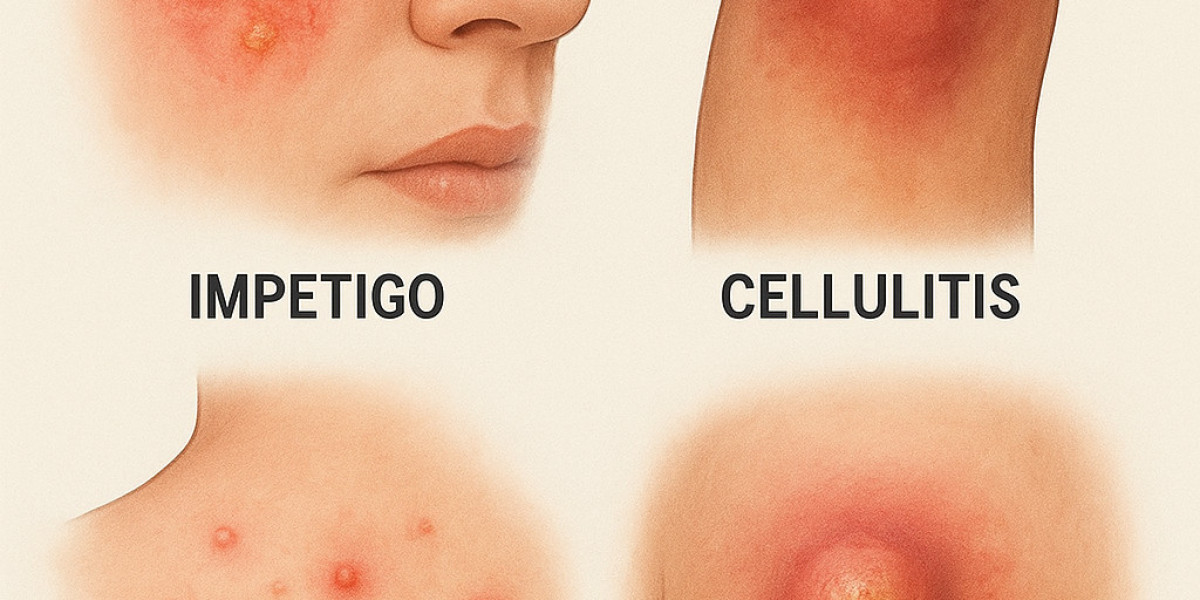Bacterial skin infections are some of the most common medical conditions encountered across the world. While many are mild and easily treatable, others can progress to severe, life-threatening illnesses if left unchecked. Understanding the symptoms, causes, and treatment options is crucial for prevention and early intervention.
What Are Bacterial Skin Infections?
A bacterial skin infection occurs when harmful bacteria invade the skin or its underlying tissues. These infections can affect any age group, from infants to the elderly, and may range from superficial infections such as impetigo to deep tissue infections like cellulitis.
The most common bacterial culprits include
Staphylococcus aureus
Streptococcus pyogenes
Less commonly, Gram-negative bacteria such as Pseudomonas aeruginosa
These pathogens enter the body through cuts, insect bites, surgical wounds, or other breaks in the skin barrier.
Common Symptoms of Bacterial Skin Infections
The symptoms depend on the specific type of infection, its severity, and the individual’s immune response. However, some hallmark signs are shared across most bacterial skin infections.
1. Redness (Erythema)
One of the first visible signs is localized redness. The affected area may appear flushed, warm, and progressively expand if untreated.
2. Swelling
Inflammation causes the skin to swell, often making the area tender or painful to the touch.
3. Pain and Tenderness
Discomfort is a key indicator. Pain may range from mild to severe, particularly in infections that extend deeper into tissues.
4. Warmth Over the Area
Infected skin often feels noticeably warmer compared to surrounding tissue, signaling the body’s inflammatory response.
5. Pus or Discharge
Infections such as abscesses or boils produce pus a thick fluid consisting of dead bacteria, white blood cells, and tissue debris.
6. Crusting and Oozing
Impetigo and related infections can cause honey-colored crusts or oozing lesions.
7. Fever and Malaise
More serious bacterial skin infections may trigger systemic symptoms like fever, chills, and fatigue. This suggests the infection could be spreading.
8. Rapidly Spreading Rash
Cellulitis, for example, can spread quickly, with redness and swelling extending beyond the initial site.
Types of Bacterial Skin Infections and Their Symptoms
1. Impetigo
Common in children
Appears as red sores, often around the nose and mouth
Sores rupture and form golden-yellow crusts
Itchy but not typically painful
2. Cellulitis
Affects deeper layers of skin and underlying tissues
Symptoms: redness, swelling, pain, and fever
Can spread quickly and may become life-threatening if untreated
3. Folliculitis
Infection of hair follicles
Appears as small, red bumps or pimples
May itch or cause mild pain
4. Boils (Furuncles) and Carbuncles
Caused by Staphylococcus aureus
Painful, pus-filled lumps under the skin
Carbuncles are clusters of boils that can cause fever
5. Erysipelas
A form of cellulitis with raised, sharply demarcated borders
Red, swollen skin with a shiny appearance
Often accompanied by fever and chills
Risk Factors for Bacterial Skin Infections
Cuts, scrapes, or open wounds
Poor hygiene
Weakened immune system
Chronic conditions (diabetes, vascular disease)
Crowded living conditions (e.g., schools, barracks)
Skin conditions (eczema, athlete’s foot)
When to Seek Medical Attention
While minor infections sometimes resolve with basic wound care, urgent medical help is necessary if you notice:
Rapidly spreading redness or swelling
Severe pain or tenderness
Fever and chills accompanying skin symptoms
Pus-filled abscesses that do not drain on their own
Red streaks extending from the infection site (a sign of lymphangitis)
Treatment Options for Bacterial Skin Infections
Topical Antibiotics
Mild infections like impetigo are often treated with antibiotic creams or ointments.
Oral Antibiotics
More serious infections such as cellulitis often require oral antibiotics. Cephalexin, a first-generation cephalosporin, is one of the most commonly prescribed options. It is effective against both Staphylococcus and Streptococcus species, making it a frontline treatment.
Drainage
Abscesses and boils may need to be drained by a healthcare professional to remove pus and speed up healing.
Supportive Care
Rest, hydration, and pain management are important for recovery.
Cephalexin and Its Importance in Treatment
Cephalexin works by interfering with bacterial cell wall synthesis, ultimately leading to bacterial death. It is widely prescribed because:
It covers common skin infection pathogens
It has a good safety profile
It is available in capsules, tablets, and suspension formulations
Hospitals, clinics, and pharmacies often rely on a dependable cephalexin capsules supplier to ensure consistent stock, especially since skin infections are so prevalent globally.
A trusted supplier guarantees:
High-quality, GMP-compliant production
Affordable bulk pricing for healthcare systems
Reliable delivery timelines
Proper storage conditions to maintain efficacy
Healthcare providers must partner with a licensed and verified cephalexin capsules supplier to reduce risks of counterfeit or substandard medications entering the supply chain.
Prevention of Bacterial Skin Infections
Wash hands regularly with soap and water
Keep cuts, scrapes, and wounds clean and covered
Avoid sharing personal items like razors or towels
Shower after sports or heavy sweating
Wear breathable fabrics to prevent excessive moisture buildup
Manage underlying conditions like diabetes to reduce infection risk
Conclusion
Bacterial skin infections are common but potentially serious conditions. Symptoms range from redness, swelling, and pus formation to fever and systemic illness in severe cases. Prompt recognition and treatment are vital to avoid complications.
Antibiotics such as cephalexin remain an essential weapon against these infections. For healthcare systems and pharmacies, partnering with a trustworthy cephalexin capsules supplier ensures patients receive safe and effective medications.
By staying aware of the symptoms, practicing preventive measures, and ensuring access to reliable treatments, individuals and communities can better protect themselves from the burden of bacterial skin infections.















